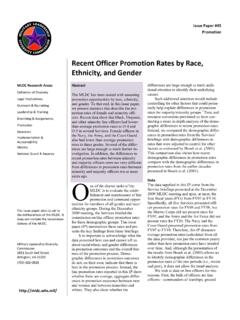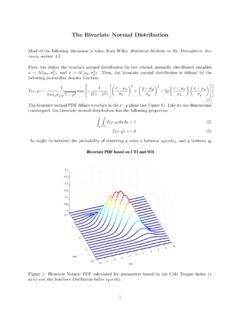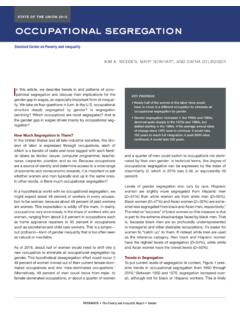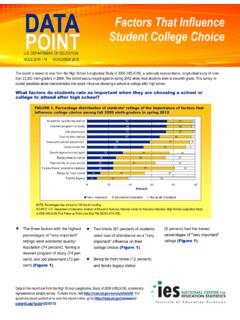Transcription of The Gender Similarities Hypothesis
1 The Gender Similarities Hypothesis Janet Shibley Hyde University of Wisconsin Madison The differences model, which argues that males and fe- searchers highlighted Gender Similarities . Thorndike males are vastly different psychologically, dominates the (1914), for example, believed that psychological Gender popular media. Here, the author advances a very different differences were too small, compared with within- Gender view, the Gender Similarities Hypothesis , which holds that variation, to be important. Leta Stetter Hollingworth (1918). males and females are similar on most, but not all, psy- reviewed available research on Gender differences in men- chological variables. Results from a review of 46 meta- tal traits and found little evidence of Gender differences. analyses support the Gender Similarities Hypothesis . Gen- Another important reviewer of Gender research in the early der differences can vary substantially in magnitude at 1900s, Helen Thompson Woolley (1914), lamented the gap different ages and depend on the context in which mea- between the data and scientists' views on the question: surement occurs.
2 Overinflated claims of Gender differences carry substantial costs in areas such as the workplace and The general discussions of the psychology of sex, whether by relationships. psychologists or by sociologists show such a wide diversity of points of view that one feels that the truest thing to be said at Keywords: Gender differences, Gender Similarities , meta- present is that scientific evidence plays very little part in produc- analysis, aggression ing convictions. (p. 372). T he mass media and the general public are captivated by findings of Gender differences. John Gray's (1992) Men Are From Mars, Women Are From Venus, which argued for enormous psychological differ- ences between women and men, has sold over 30 million The Role of Meta-Analysis in Assessing Psychological Gender Differences Reviews of research on psychological Gender differences copies and been translated into 40 languages (Gray, 2005).
3 Began with Woolley's (1914) and Hollingworth's (1918). Deborah Tannen's (1991) You Just Don't Understand: and extended through Maccoby and Jacklin's (1974) wa- Women and Men in Conversation argued for the different tershed book The Psychology of Sex Differences, in which cultures Hypothesis : that men's and women's patterns of they reviewed more than 2,000 studies of Gender differ- speaking are so fundamentally different that men and ences in a wide variety of domains, including abilities, women essentially belong to different linguistic communi- personality, social behavior, and memory. Maccoby and ties or cultures. That book was on the New York Times Jacklin dismissed as unfounded many popular beliefs in bestseller list for nearly four years and has been translated psychological Gender differences, including beliefs that into 24 languages (AnnOnline, 2005).
4 Both of these works, girls are more social than boys; that girls are more and dozens of others like them, have argued for the differ- suggestible; that girls have lower self-esteem; that girls are ences Hypothesis : that males and females are, psychologi- better at rote learning and simple tasks, whereas boys are cally, vastly different. Here, I advance a very different better at higher level cognitive processing; and that girls view the Gender Similarities Hypothesis (for related state- lack achievement motivation. Maccoby and Jacklin con- ments, see Epstein, 1988; Hyde, 1985; Hyde & Plant, 1995; cluded that Gender differences were well established in Kimball, 1995). only four areas: verbal ability, visual-spatial ability, math- The Hypothesis ematical ability, and aggression. Overall, then, they found much evidence for Gender Similarities .
5 Secondary reports The Gender Similarities Hypothesis holds that males of their findings in textbooks and other sources, however, and females are similar on most, but not all, psychological focused almost exclusively on their conclusions about gen- variables. That is, men and women, as well as boys and girls, are more alike than they are different. In terms of der differences ( , Gleitman, 1981; Lefranc ois, 1990). effect sizes, the Gender Similarities Hypothesis states that most psychological Gender differences are in the close-to- Preparation of this article was supported in part by National Science zero (d ) or small ( d ) range, a few are Foundation Grant REC 0207109. I thank Nicole Else-Quest, Sara Lind- in the moderate range ( d ), and very few are berg, Shelly Grabe, and Jenni Petersen for reviewing and commenting on large (d ) or very large (d ).
6 A draft of this article. Correspondence concerning this article should be addressed to Janet Although the fascination with psychological Gender Shibley Hyde, Department of Psychology, University of Wisconsin . differences has been present from the dawn of formalized Madison, 1202 West Johnson Street, Madison, WI 53706. E-mail: psychology around 1879 (Shields, 1975), a few early re- September 2005 American Psychologist 581. Copyright 2005 by the American Psychological Association 0003-066X/05/$ Vol. 60, No. 6, 581 592 DOI: Gender meta-analyses generally proceed in four steps: (a) The researcher locates all studies on the topic being reviewed, typically using databases such as PsycINFO and carefully chosen search terms. (b) Statistics are extracted from each report, and an effect size is computed for each study. (c) A weighted average of the effect sizes is com- puted (weighting by sample size) to obtain an overall assessment of the direction and magnitude of the Gender difference when all studies are combined.
7 (d) Homogeneity analyses are conducted to determine whether the group of effect sizes is relatively homogeneous. If it is not, then the studies can be partitioned into theoretically meaningful groups to determine whether the effect size is larger for some types of studies and smaller for other types. The researcher could ask, for example, whether Gender differ- ences are larger for measures of physical aggression com- pared with measures of verbal aggression. The Evidence To evaluate the Gender Similarities Hypothesis , I collected Janet Shibley the major meta-analyses that have been conducted on psy- Hyde chological Gender differences. They are listed in Table 1, grouped roughly into six categories: those that assessed cognitive variables, such as abilities; those that assessed verbal or nonverbal communication; those that assessed Shortly after this important work appeared, the statistical social or personality variables, such as aggression or lead- method of meta-analysis was developed ( , Glass, McGaw, ership; those that assessed measures of psychological well- & Smith, 1981; Hedges & Olkin, 1985; Rosenthal, 1991).
8 Being, such as self-esteem; those that assessed motor be- This method revolutionized the study of psychological Gender haviors, such as throwing distance; and those that assessed differences. Meta-analyses quickly appeared on issues such as miscellaneous constructs, such as moral reasoning. I began Gender differences in influenceability (Eagly & Carli, 1981), with meta-analyses reviewed previously by Hyde and Plant abilities (Hyde, 1981; Hyde & Linn, 1988; Linn & Petersen, (1995), Hyde and Frost (1993), and Ashmore (1990). I. 1985), and aggression (Eagly & Steffen, 1986; Hyde, 1984, updated these lists with more recent meta-analyses and, 1986). where possible, replaced older meta-analyses with more Meta-analysis is a statistical method for aggregating up-to-date meta-analyses that used larger samples and bet- research findings across many studies of the same question ter statistical methods.
9 (Hedges & Becker, 1986). It is ideal for synthesizing re- Hedges and Nowell (1995; see also Feingold, 1988). search on Gender differences, an area in which often dozens have argued that the canonical method of meta-analysis . or even hundreds of studies of a particular question have which often aggregates data from many small convenience been conducted. samples should be augmented or replaced by data from Crucial to meta-analysis is the concept of effect size, large probability samples, at least when that is possible which measures the magnitude of an effect in this case, ( , in areas such as ability testing). Test-norming data as the magnitude of Gender difference. In Gender meta-anal- well as data from major national surveys such as the yses, the measure of effect size typically is d (Cohen, National Longitudinal Study of Youth provide important 1988): information.
10 Findings from samples such as these are in- MM MF cluded in the summary shown in Table 1, where the num- d , ber of reports is marked with an asterisk. sw Inspection of the effect sizes shown in the rightmost where MM is the mean score for males, MF is the mean column of Table 1 reveals strong evidence for the Gender score for females, and sw is the average within-sex standard Similarities Hypothesis . These effect sizes are summarized deviation. That is, d measures how far apart the male and in Table 2. Of the 128 effect sizes shown in Table 1, 4 were female means are in standardized units. In Gender meta- unclassifiable because the meta-analysis provided such a analysis, the effect sizes computed from all individual wide range for the estimate. The remaining 124 effect sizes studies are averaged to obtain an overall effect size reflect- were classified into the categories noted earlier: close-to- ing the magnitude of Gender differences across all studies.
















